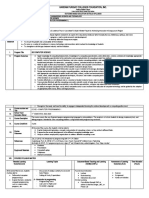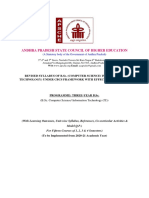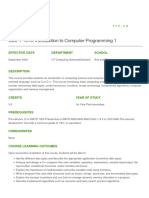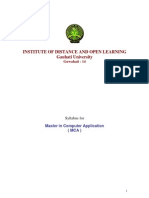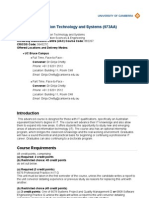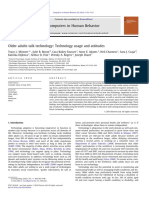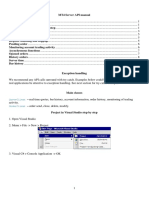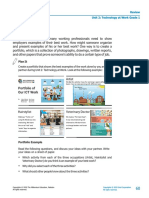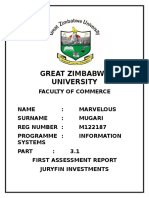Planning and Quality Assurance Affairs
Form (A)
Course Specifications
General Information
Course name Introduction to Computing
Course number ITCS1401
Faculty
Department
Course type College Needs
Course level 1
Credit hours (theoretical) 3
Credit hours (practical) 1
Course Prerequisites
Course Objectives
1 - Increase familiarity with computers, their components and their operations.
2 - Explain how computers store and manipulate information.
3 - Identifying the steps involved in creating a program and itemize the elements of a typical program.
4 - Understanding the essential of the concepts of Programming Techniques.
5 - Understanding the nature and function of a high level language’s constructs and syntax(C++)
6 - The concept of control constructs
7 - The concept of Looping techniques
8 - key concepts of simple and dynamic data structures
9 - Describe how functions are constructed and implemented.
10 - Give a brief account of library functions and user-defined functions.
11 - Write a complete C++ program using the different statements of the C++ language.
Page 1 of 4
� Intended Learning Outcomes
Knowledge and Understanding
* a1- Use high-level programming languages.
* a2. Outline fundamental topics in computer systems, including hardware
architectures and operating systems
* a3. Define the concept of an algorithm and a few specific examples of
algorithms
* a4. Identify the essential of the concepts of Programming Techniques.
* a5. Describe fundamental topics in computing including software
architectures, software engineering principles and methodologies and
software tools.
* a6. Outline basic knowledge and understanding of a core of analysis.
* a7. Explain the nature and function of a high level language’s constructs and
syntax(C++)
* a8. Describe the concept of control constructs
* a9. Explain Looping techniques
* a10. Describe key concepts of simple and dynamic data structures
* a11. Identifythe tools, practices and methodologies used in the specification,
design, implementation and evaluation of computer programs.
Intellectual Skills
* b1. Perform problem analysis from written descriptions; derive requirements
specifications from an understanding of problems (analysis, synthesis).
* b2. Break a large problem into smaller parts, writing each part as a module or
function.
* b3. Generate an innovative design to solve a problem containing a range of
commercial and industrial constraints.
* b4. Analyze the requirements of a range of computer-based systems and
examine the design alternatives based on the constraints imposed by
society, organizations, and technology.
* b5. Work with and model computer systems at different and appropriate
levels of abstraction.
* b6. Enhance ability to approach problems systematically.
Professional Skills
* c1. Use appropriate programming languages and tools, and design
methodologies.
* c2. Interpret verbal problem specifications into program code
* c3. Design, write and debug computer programs in C++ language
General Skill
* d1. Communicate effectively by oral, written and visual means.
* d2. Develop interpersonal skills planning and managing personal time and
work.
* d3. Work effectively as an individual and as a member of a team.
* d4. Manage tasks and resources.
* d5. Manage ones own learning and development, including time management
and organizational skills.
Course Contents
1 - Computer definition and different computer types.
2 - Data representation.
3 - Introduction to Algorithms, problem-solving and software development methodology.
4 - Basic programming in C++, essential concepts, programming style, variables and data types, long, float,
double, Boolean, character, strings, enumeration, I/O format,
5 - Logical expressions and control constructs: if-else, nested if, switch, arithmetic and assignment statements;
6 - Looping techniques, for, while, do-while, nested loop, functions, including parameter passing mechanisms,
scope, and return values, pointers
7 - Introduction to structures and arrays.
Page 2 of 4
� Teaching and Learning Methods
1 - Lectures
2 - Tutorial Exercises
3 - Practical Exercises
4 - Projects
Students Assessment
Assessment Method TIME MARKS
Final Exam Week 16 50%
Practical Exercises 15%
Mid-Term Exam Week 8 20%
Projects 15%
Books and References
Course note Short course notes available at doctor’s office.
Essential books H. M. Deitel. P. J. Deitel, “C How To Program”, Prentice Hall 2004, Fourth Edition.
Recommended books J. Hanley, E. Koffman, Problem Solving & Program Design In C, Pearson Education,
International of 7th edition (May 1, 2012)
Brian W. Kernighan, Dennis M. Ritchie, The C programming language, 2nd edition, 1988.
Knowledge and Skills Matrix
Main Course Contents Study Week Knowledge and Intellectual Skills Professional Skills General Skill
Understanding
Computer definition and 1 a2 d1-d5
different computer types.
Data representation. 2-3 a2,a4 d1-d5
Introduction to Algorithms, 4 a1,a3,a4,a5,a6 b1,b4 c1-c3 d1-d5
problem-solving and software
development methodology.
Basic programming in C++, 5-6 a8, a9, a12 b1-b5 c1-c3 d1-d5
essential concepts,
programming style, variables
and data types, long, float,
double, Boolean, character,
strings, enumeration, I/O
format,
Logical expressions and 7-8 a7,a8,a11 b2, b3, b5 c1-c3 d1-d5
control constructs: if-else,
nested if, switch, arithmetic
and assignment statements.
Looping techniques, for, while, 9-11 a7,a8,a9,a11 b2, b3, b4, b5 c1-c3 d1-d5
do-while, nested loop,
functions, including parameter
passing mechanisms,
scope, and return values,
pointers.
Introduction to structures and 12-14 a8, a10, a11 b2-b6 c1-c3 d1-d5
arrays.
Page 3 of 4
�Page 4 of 4



